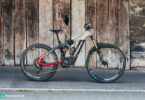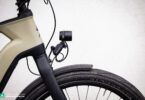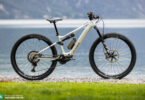Designed in the UK and aimed at the British E-MTB market, the Diamondback Ranger 2.0 offers riders Shimano Steps 8000, WTB 27+ wheels and 140 mm of RockShox suspension for £ 3900. We took it to the edge and back in the mountains and hills of Scotland, to see where it was most comfortable.
Diamondback, have been part of the MTB scene since year dot and were one of the hottest brands of the late 80’s. Since then they nearly disappeared until the mighty Raleigh and its parent company, Winora (the owners of Haibike), invested heavily in the brand and have re-invented Diamondback as a British E-MTB contender. Aimed at riders looking for a solid all-rounder with maximum bike for their money, the Ranger is Diamondback’s top-end model for 2017 and the 2.0 sits in the middle of three spec levels, all based around the same frame and motor.

1st impressions are good: the aluminium 6061 hydroformed frame looks solidly built and features a VPP linkage rear end. Frame colours look good and definitely ‘pop’ but the graphic finish is a bit lacklustre with the decals standing proud and die-cut stickers on the battery. Up close, the cable routing is a bit of a ‘bird’s nest’, which makes it more difficult to work on when you need to change a cable or adjust the dropper and the lack of bottle cage mounts mean that you’re limited to using a hydration pack even for short blasts. However, a few corners have to but cut to be competitive at this price point and these non-essential areas are the probable place to do it.
Specification of the Diamondback Ranger 2.0
The beating heart of the bike is the excellent Shimano Steps E8000 motor with 500 Wh external battery. The Steps E8000 gives a smooth and quiet ride with plenty of power, even on ECO mode, with enough torque available on trail to get up all but the most brutal of climbs. There is noticeably less drag than other motors, at speeds above the assisted range, which means even more flow and fun on the fast stuff!

The beating heart of the bike is the excellent Shimano Steps E8000 motor with 500 Wh external battery.
RockShox at both ends are well specced for the price point, with the burly Yari RC up front and the Monarch RT3 with 3 position compression lever bringing up the rear. Both are simple to set-up; just set the sag according to the gradient markings already on the shock, and go, if you blow through your travel too quickly, adding the bottomless tokens is an easy and quick job. Drive chain duties are carried out by Shimano XT 11-speed shifter and mech on an 11-42 Sunrace cassette which, combined with a 34t XT chainset, gave plenty of range and shifted well under pressure. Another £ 350 gets you XT Di2 on the Ranger 3.0 and it may be worth the money to have a more integrated and quicker shifting bike that gets the most out of the Steps E8000 drive.




The well-specced theme continues with the wheels. 40 mm internal width WTB Scraper rims and 2.8” tyres are good to see, giving added comfort and a larger contact patch to aid grip and braking traction, however, they will need converting to tubeless to avoid the frequent pinch punctures a heavy bike, tubes and thin side walls will attract like bees to honey!

By either strange coincidence or careful planning, the WTB tyres are the appropriately named, Rangers; the low profile tread worked really well for cruising on fast rolling and dry, hardpack and trail centre type surfaces but would quickly get you in trouble in wet or loose conditions. Tyres with more traction would make the most out of the bike’s excellent climbing ability and provide more confidence when descending..
Fork: Rock Shox Yari RC 140 mm
Rear Shock: Rock Shox Monarch RT3 Debonair 140 mm
Wheelset: WTB Scraper i40 27+ 32H on DB Sealed Boost Hubs
Tyres: WTB Ranger 27.5×2.8, Comp 27tpi Casing, Wire Bead
Drive Unit: Shimano E8000
Battery: Shimano Integrated E8020 (504 Wh)
Crankset: Shimano XT E8000 34t Ring
Drivetrain: Shimano XT Sunrace 11-42t
Brakes: Shimano M-315 Hydraulic, 180mm Rotor
Stem: Diamondback Forged Aluminium
Handlebar: Diamondback W:720 x Dia:31.8mm, Back sweep:6DG Up sweep:4, Rise:12mm Cut for WTB Padlock Grips
Seatpost: DB Dropper post 31.6mm
Geometry of the Diamondback Ranger 2.0
| Size | S | M | L | XL |
|---|---|---|---|---|
| Seat tube | 380 mm | 420 mm | 460 mm | 500 mm |
| Top tube (effective) | 585 mm | 605 mm | 625 mm | 645 mm |
| Head tube | 110 mm | 110 mm | 120 mm | 130 mm |
| Head angle | 68° | 68° | 68° | 68° |
| Seat angle | 75° | 75° | 75° | 75° |
| Chainstay | 455 mm | 455 mm | 455 mm | 455 mm |
| BB Drop | 25 mm | 25 mm | 25 mm | 25 mm |
| Wheelbase | 1169 mm | 1189 mm | 1210 mm | 1231 mm |
Riding the Diamondback Ranger 2.0

We tested the XL and the short reach felt a bit on the small side for our 193 cm lanky tester; riders 180-190 cm would fit it much better. The geometry is traditionally sharp XC with a comfortable and upright position and a 68° head angle which means that it loves tight singletrack and climbing and will happily eat up the kilometres.

Unfortunately, for fast descending, those low profile tyres, steep head angle, short top tube, 70 mm stem and 720 mm bars make the handling a bit of a handful! We would have definitely have liked to see a wider bar at least, to give the rider more leverage, control and confidence. The real fly in the spec ointment are the M-315 brakes, which really have no place on an E-MTB let alone one at £ 3900, and are the cheapest Shimano units with hideous 2 finger trekking levers.

Brakes are not an area that we like to see compromised on an E-MTB because of the increased speeds and weight. Low powered units require two or more fingers to operate in order to get them to bite which reduces your ability to grip the bars and increases arm pump and pressure on the wrists. On long descents, we spent so much time thinking about braking, resulting in tired wrists and arms which took much of the fun out of the descents and ultimately made riding riskier. These would need sorting in the shop and buyers should consider this when comparing the total cost of the bike. Unfortunately, the same brakes are specced on the Ranger 3.0 so even upgrading to the next model won’t rectify the issue.
Conclusion
The Ranger is designed, as its name suggests, for long tours and adventure. We were happiest exploring the forests and double track of the Borders backcountry where our confidence in the range and comfort of the Ranger, kept us heading towards the horizon. Riders looking to get radical will find the Ranger’s specification unsuitable for harder riding, quickly getting out of its depth when the terrain, speeds, and gradient become more challenging.
More info at: diamondback.co.uk
Did you enjoy this article? If so, we would be stoked if you decide to support us with a monthly contribution. By becoming a supporter of E-MOUNTAINBIKE, you will help secure a sustainable future for high-quality cycling journalism. Click here to learn more.
Words: Thomas Corfield Photos: Trev Worsey








